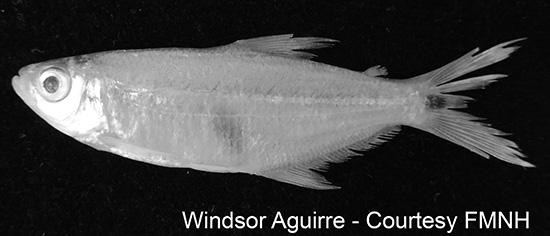Characidae - Landonia latidens Eigenmann and Henn, 1914 |
 |
| SOURCE FOR OCCURRENCE IN ECUADOR: Many sources for its occurrence in western Ecuador (e.g., Eigenmann, 1922; Roberts, 1973; Glodek, 1978; Barriga, 1991). |
| ORIGINAL DESCRIPTION: Eigenmann, C.H., A.W. Henn, and C. Wilson. 1914. New fishes from western Colombia, Ecuador, and Peru. (Contrib. Zool. Lab. Ind. Univ. No. 133.). Indiana University Studies No. 19:1-15. |
| TYPE SPECIMENS: |
| TAXONOMIC STATUS: Valid (Eschmeyer and Fricke, 2011). |
| RANGE ECUADOR: Guayas River basin (Glodek, 1978). |
| RANGE OUTSIDE OF ECUADOR: Traditionally, this species has been considered endemic to the Guayas River basin (e.g., Roberts, 1973; Glodek, 1978). However, Meza-Vargas et al. (2019) recently reported collections of Landonia latidens from multiple locations in the Chira and Piura river basins in northwestern Peru between 2007 and 2018. The collection over multiple years and sites indicates that there is an established population of Landonia in Peru. Despite collection efforts in southwestern Ecuador in the Churute, Balao, Jubones, and Santa Rosa rivers (Aguirre, unpublished data) and in northwestern Peru in the Tumbes river (Meza-Vargas et al., 2019), Landonia has not been collected in the area between the Guayas and Chira river basins. Thus the Guayas and Peruvian populations appear to be isolated from one another by a relatively large geographic gap. |
| COLLECTIONS IN ECUADOR: |
| MAXIMUM SIZE: 42 mm SL (Fishbase, 2011). |
| DISTINGUISHING FEATURES: Males of this species have a specialized gland and modified scales on the caudal peduncle. The adipose fin is present (it is absent in Iotabrycon). A dark spot is present at the base of the midcaudal-fin rays and a median stripe along the flank of the body. Meristics: 11 dorsal fin rays, 31-32 anal fin rays, and 45-50 lateral line scales (Glodek, 1978). The presence of two rectangular, sharp maxillary teeth is characteristic of this species (Meza-Vargas et al., 2019). The body tends to be more elongate then other tetras in the region like Astyanax, Rhoadsia, and Bryconamericus. |
| ECOLOGY: This is a small tetra that does not appear to be very abundant. Roberts (1973) reported it as occurring in backwaters of large rivers. He also examined the stomach contents of a few specimens and found segmented fin rays, scales appearing to belong to small tetras and what seemed to be filamentous algae. No specimens had insect remains, sand or soil. Meza-Vargas et al. (2019) examined the stomach contents of a few specimens from the Peruvian population and found chironomid larvae, filamentous algae, and fish scales and fin rays. |
| ECONOMIC IMPORTANCE: This is a small species of no direct economic importance. |
| CONSERVATION STATUS: NA, however, this species was not common in collections made by Aguirre et al. in mountain streams on the western slopes of the Ecuadorian Andes between 2008 and 2018 (Aguirre, unpublished data). It may be more common in wetlands like Abras de Mantequilla near Vinces (Alvarez, 2019). |
| LINK TO FISHBASE PAGE: Click here for link |
| SPECIES PROFILE CREATED BY: Windsor Aguirre |
| SPECIES PROFILE CONTRIBUTORS: NA |
|
|
|
|
|
